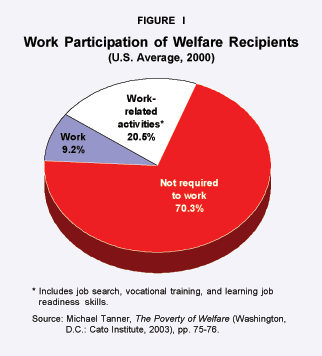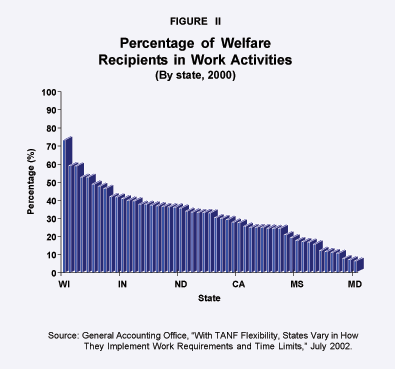Recently, for the fifth time, Congress temporarily extended the 1996 welfare reform law that established Temporary Assistance to Needy Families (TANF), the federal program that provides cash assistance to poor families. The Bush Administration and the House of Representatives have sought to improve TANF by adopting stronger work requirements, while simultaneously increasing child care funding by $2 billion. Legislation to reauthorize the program has been held up by the Senate, which continues to resist the administration's push for stronger work requirements.
This is unfortunate. Studies have found that strictly enforced work requirements were the most important reason for TANF caseload reductions over the past decade. A stronger emphasis on employment would further reduce the attractiveness of welfare and strengthen recipients' motivation to find a job and keep it.
Successes So Far. With the goal of reducing welfare dependency, TANF introduced a number of significant reforms, including time limits on the receipt of benefits, work requirements and an array of financial incentives. The results have been positive:
- From 1996 to 2002, the number of families on welfare fell from 4.5 million to 2.1 million, and caseloads continue to remain at low levels despite the recent economic slowdown.
- Between 63 and 87 percent of those leaving welfare have found employment, with the average household income of welfare leavers reaching about 125 percent of the poverty level.
- The reduction in welfare rolls has not contributed to an increase in poverty; today, just 9.6 percent of families live in poverty – one of the lowest levels on record.
Need: Fewer Exemptions from Work. Due to declining welfare caseloads, states were given credits that lowered the work participation requirements for those remaining on the rolls. In fact, Michael Tanner of the Cato Institute says that in 31 states caseload reduction credits decreased the actual number of recipients required to work to zero. Further, many states exempt a large portion of adult welfare recipients, including: parents of young children (47 states); individuals who lack adequate transportation or face other barriers to work (28 states); and parents who cannot find adequate child care (28 states).
Lastly, 14 states have waivers from previous reform initiatives that override TANF's current work requirements. When all the credits, exemptions and waivers are tallied, less than 30 percent of adult welfare recipients across the country actually participate in work activities.

And even those recipients aren't necessarily working. Research strongly suggests that the most successful form of work activity for welfare recipients is work itself, yet most states allow job search, vocational training, and learning job readiness skills to qualify as work [see Figure I]. In fact, only 9.2 percent of all adult welfare recipients are actually employed, representing less than 200,000 jobs.
Need: Tougher Work Requirements. The bill passed by the House last year would raise the required participation rate among adult recipients to 70 percent, up from the current level of 50 percent. Moreover, the House has proposed increasing the 30-hour work week to 40 hours, of which at least 24 must be spent in employment. The House bill also requires states to strengthen sanctions, which reduce or stop recipients' welfare payments for noncompliance with work requirements.
Tougher work requirements are needed to increase work participation rates across the country. Wisconsin has demonstrated that a strong focus on employment can bring about participation rates exceeding 70 percent. However, other states have not been as focused on work. For example, a meager 6.3 percent of welfare recipients in Maryland are involved in work-related activities. [See Figure II.] Many other states also have significant room for improvement.
Need: Focus on Private-Sector Employment. While stronger work requirements are important, policymakers should also promote unsubsidized private sector employment. Research has shown that community service or government subsidized job programs tend to create temporary make-work – such as such as picking up garbage, raking leaves and painting government buildings – that do not prepare recipients for long-term self-sufficiency. By contrast, workers in the private sector develop marketable job skills that help people stay off of welfare, in part because they are trained in occupations valued by employers.
Furthermore, government does not actually "create" jobs. Publicly funded work comes at the direct expense of private sector opportunities because they are funded either through tax dollars or deficit spending. When taxpayers have less money to spend or invest in the private sector, businesses respond by producing fewer goods and either stop hiring or lay off workers. Not only do job creation programs directly reduce the growth of private sector jobs, government subsidized workers actually take jobs away from current workers. Research shows that even the most effectively run job creation program displaces about one existing worker for every four jobs it creates.

Opportunities. Although some barriers still exist, remaining welfare recipients can find work. Despite the great reductions in caseloads, research suggests that the proportion of harder-to-serve, long-term recipients – young single mothers, minorities and those without a high school education – has stayed about the same. The Urban Institute found that between 1997 and 1999, a period of significant caseload reduction, the percentage of long-term welfare cases remained even – at about 47 percent. In fact, an NCPA study found that those most at risk for long-term dependency have left the welfare rolls at higher rates than other groups.
Welfare leavers also have many job opportunities. William Conerly of the American Institute for Full Employment says an unemployed person doesn't need a net new job, just any open job. People most commonly find work when jobs open up as a result of
normal employee turnover. Another common source of employment is "churn." That is, jobs are gained when some firms expand, while others are lost when some firms close down. Thus, in a market economy, a 2 percent net new job growth likely reflects a 12 percent gross increase in new jobs offset by a 10 percent reduction in existing jobs.
Conclusion. Welfare reform reauthorization must strengthen work requirements by reducing exemptions and stressing the importance of private sector employment. It is time for lawmakers to build on past success and empower welfare recipients to lead happier, more productive lives.
Joe Barnett is a policy analyst and director of publications, and Todd Gabel is an intern, at the National Center for Policy Analysis.